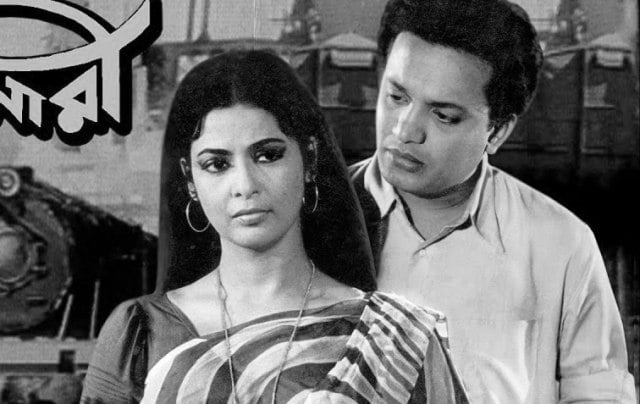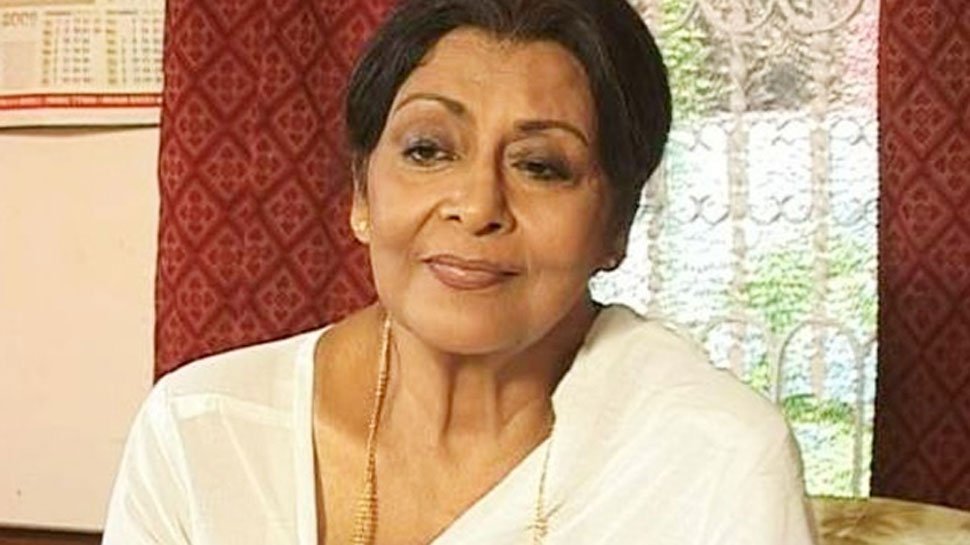This article is a part of the #IndianWomenInHistory campaign for Women’s History Month to remember the untold legacies of women who shaped India, especially India’s various feminist movements. One Indian woman is profiled each day for the whole of March 2019.
Hers was a familiar face in the celluloid world of Bengal in the post-independent India. Who can forget her sharp features, the enigmatic smile, poise and graceful movements? Supriya Devi entered the tinsel world in an era when several stalwarts including Uttam Kumar, Savitri Chatterji and Soumitra were at
Early Life
On 8th January 1933, she was born as Krishna Banerjee in Michkina, Burma (now Myanmar). Though they originally hailed from Faridpur (now in Bangladesh) the family had moved to Burma in quest of fortune. Against the backdrop of the second world war, her family was compelled to exit Burma after it was captured by the Japanese forces. Finally, they permanently settled down in Calcutta (Kolkata) in 1948.

During her childhood days in Burma, little Supriya learnt dance and music. On one occasion she received accolades from Thakin Nu, the erstwhile Prime Minister of Burma who was impressed by her talent. After migrating to Calcutta, Supriya resumed her training in dance under the tutelage of Guru Muruthappan Pillai followed by Guru Prahlad Das.
Beginning Of Career
Did you know that at age seven the little girl acted in two plays directed by her father? However, she had never given any thought to the idea of trying her hand at acting. Interesting to note, a well-known actress Chandrabati Devi, happened to be a neighbour of the family. It was she who coaxed and persuaded the teenager to try her luck in the arena of Bengali films. Accordingly, Supriya made her film debut with Basu Paribar (1952) directed by Nirmal Dey with Uttam Kumar in the lead role. Later that year she also appeared in two more films namely Prarthana and Shyamali.
The 1960s and 1970s were golden periods for Supriya as most of her films were critically appreciated and were became hits.
Thereafter, she took a hiatus only to return in 1958. She acted in a series of well-known films including Sushil Majumdar’s Marmabani followed by Mangal Chakraborty’s blockbuster Sonar Harin (1959). That very year she was catapulted to fame for essaying the role of Amrapali (a courtesan) in the film of the same name. Her performance elicited praise from reputed actress Vaijayanthimala who enacted the same role in a Hindi version of the film in 1966.
Rise To Fame
Thereafter, the plucky woman put her tragic past behind her and determined to pick up the threads of life again. In 1960 came her magnum opus Meghe Dhaka Tara (cloud-capped star) by the legendary director Ritwik Ghatak. It is still rated as his most outstanding one.
Also read: Suchitra Sen: From Mahanayika To Recluse | #IndianWomenInHistory
The poignant melodrama revolves around Neeta (Supriya) a beautiful young lady who along with her siblings and parents lives in abject poverty and penury in the aftermath of the Partition, in a Calcutta suburb. She is by nature self-effacing, caring and dutiful. Paradoxically this trait of hers is exploited by her kin as well as those around her. Misfortune dogs her at every step – her fiancé jilts her, she loses her job and finally contracts tuberculosis. Sadly, nobody ventures to help her except her older brother an unemployed aspiring singer. As the film tapers to its close, Neeta is depicted as flinging herself into her brother’s arms and wailing “Dada ami kintu banchte cheyechilam… dada ami banchbo… dada ami banchbo” (Brother, I just wanted to live… brother, I want to live… brother, I want to live). This portrayal of a dying woman’s desire to live made it a heart-wrenching finale – for which her iconic role got her much appreciation.
After bidding adieu to the tinsel world Supriya decided to focus on her second passion – culinary arts! A master chef with decades of experience she hosted the popular cookery show Benudir Rannaghar on television.
The 1960s and 1970s were golden periods for Supriya as most of her films were critically appreciated and were became hits. These include Shuno Baranari (1960), Komal Gandhar (1961), and another film by Ghatak, Swaralipi (1961). She gave scintillating performance opposite Uttam Kumar in films like Banpalashir Padabali, Sabarmati, Suryashikha, Kalankini Kankabati and many more. In fact, Uttam Kumar began to be paired with either Suchitra Sen or Supriya. She appeared in two Bollywood flicks Begana (1963) and Aap ki Parchhaiyaan (1964) with Dharmendra, not forgetting Kishor Kumar’s musical Door Gagan
Personal Life
In 1954, Supriya married Bishwanath Choudhury a politician. The couple had a daughter whom they named Soma. As ill-luck would have it the marriage went on the rocks, and the couple parted ways in 1958.
For a major part of her film career, Supriya shared screen space with Uttam Kumar who was better (read familiar) known as Mahanayak or the great star. Even before embarking on her film career she was acquainted with Uttam through her younger brother who was a childhood friend of the superhero. Their mutual rapport was all too well-known. Uttam Kumar had married Gauri Debi in the 1940s and had a son by her. Yet in the 1960s Supriya took a bold move which created quite a stir – she moved in with her beloved hero. While Uttam divorced his then-wife, Supriya continued to spend her life with him till his death parted them.
The Later Years
Towards the fag end of her career Supriya acted with both Uttam & Soumitra in Sarat Chandra’s Devdas, (1979), Atmiya Swajan (1998) a family drama, opposite Soumitra. Mira Nair’s The Namesake (2006) with Tabu and Irfan as her co-stars was possibly her swan song!

After bidding adieu to the tinsel world Supriya decided to focus on her second passion – culinary arts! A master chef with decades of experience she hosted the popular cookery show Benudir Rannaghar on television. She also wrote a cookery book Benudir Ranna Banna which sold like hot cakes. In 2014 the Government of India bestowed on her the prestigious Padma Shri in recognition of her contributions to the entertainment industry. She was also bagged the Bengal Film Journalists’ Award BFJA twice. In 2011, she received the Banga Vibhushan, West Bengal state’s highest civilian award.
Journey’s End
On 26th January 2018, the veteran actress breathed her last in her Ballygunj, Kolkata residence, following a cardiac arrest.
Also read: Durga Khote: The Bold Lady Of Bollywood’s Yesteryears | #IndianWomenInHistory
References
1. The Weekend Leader
2. Daily Pioneer
3. The Times Of India
About the author(s)
Delhi based Ruchira Ghosh is a trained journalist with nearly two & a half decade’s writing experience and exposure to print, web and television.




